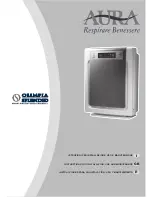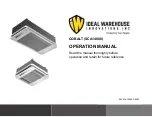
6
Line Voltage
• A wiring diagram is located on the inside cover of the
electrical box of the outdoor unit. The installer should
become familiar with the wiring diagram before making
any electrical connections to the outdoor unit.
• An electrical disconnect must be located within sight of and
readily accessible to the unit. This switch shall be capable
of electrically de-energizing the outdoor unit.
• Line voltage to the unit should be supplied from a dedicated
branch circuit containing the correct fuse or circuit breaker
for the unit. Incoming field wiring and minimum size of
electrical conductors and circuit protection must be in
compliance with information listed on the outdoor unit
data label. Any other wiring methods must be acceptable
to authority having jurisdiction.
• The outdoor unit requires electrical connections for its
incoming line voltage wiring, its safety ground wiring and
the low voltage control circuit wiring. Refer to the wiring
diagram for identification and location of outdoor unit field
wiring interfaces
). Make all electrical
connections in accordance with all applicable codes and
ordinances.
• Overcurrent protection must be provided at the branch
circuit distribution panel and sized as shown on the unit
rating label and according to applicable local codes. See
the unit rating plate for minimum circuit ampacity (MCA)
and maximum overcurrent protection (MOP) limits.
• Provide power supply for the unit in accordance with the
unit wiring diagram, and the unit rating plate. Connect the
line-voltage leads to the terminals on the contactor inside
the control compartment.
• Use only copper wire for the line voltage power supply to
this unit in strict accordance of the NEC (ANSI/NFPA 70),
applicable local codes, and the instructions provided with
the equipment. Use proper code agency listed conduit and
a conduit connector for connecting the supply wires to the
unit. Use of rain tight conduit is recommended.
• Optional equipment requiring connection to the power or
control circuits must be wired in strict accordance of the
NEC (ANSI/NFPA 70), applicable local codes, and the
instructions provided with the equipment.
Grounding
WARNING:
The unit cabinet must have an uninterrupted or
unbroken electrical ground to minimize personal
injury if an electrical fault should occur. Do not
use gas piping as an electrical ground!
This unit must be electrically grounded in accordance with
local codes or, in the absence of local codes, with the National
Electrical Code (ANSI/NFPA 70) or the CSA C22.1 Electrical
Code. Use the grounding lug provided in the control box for
grounding the unit.
Thermostat Connections
• Thermostat connections should be made in accordance
with the instructions supplied with the thermostat and the
indoor equipment.
Low Voltage Connections
• The outdoor unit is designed to operate from a 24 VAC
Class II control circuit. The control circuit wiring must comply
with the current provisions of the NEC (ANSI/NFPA 70)
and with applicable local codes having jurisdiction.
• The low voltage wires must be properly connected to the
units low voltage terminal block.






























